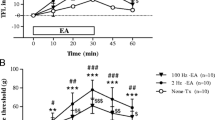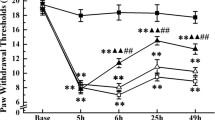Abstract
Acupuncture has been used to treat various clinical diseases in Eastern medicine. To investigate the analgesic effect of electroacupuncture (EA) pretreatment on carrageenan-induced inflammatory pain, we studied on the effect of EA parameters on an animal model of acute arthritic pain. Pretreatment with 1 mA, 10 Hz EA prior to carrageenan injection under halothane anesthesia suppressed carrageenan-induced pain. Interestingly, EA stimulation of the ‘Zu-San-Li’ (ST36) acupuncture point (1 mA, 10 Hz) contralateral to the site of the carrageenan injection in the rat synovial cavity produced significantly greater improvement of the weight-bearing force compared with EA stimulation of the ‘San-Yin-Jiao’ acupuncture point. To determine how ST36 EA treatment suppresses carrageenan-induced inflammatory pain, we examined the effect of a mu opioid receptor antagonist on ST36 EA-induced analgesia. The selective antagonist of the mu opioid receptor (OR) significantly suppressed contralateral ST36 EA-induced analgesia against carrageenan-induced inflammation. These results suggested that the analgesic effect mediated by the mu OR during low-frequency contralateral EA pretreatment has an anti-nociceptive action against inflammatory pain and that it may provide a potential strategy to treat inflammatory arthritic pain.





Similar content being viewed by others
References
Ernst E (2006) Acupuncture—a critical analysis. J Intern Med 259:125–137
Zhang SP, Zhang JS, Yung KK, Zhang HQ (2004) Non-opioid-dependent anti-inflammatory effects of low frequency electroacupuncture. Brain Res Bull 62:327–334
Son YS, Park HJ, Kwon OB, Jung SC, Shin HC, Lim S (2002) Antipyretic effects of acupuncture on the lipopolysaccharide-induced fever and expression of interleukin-6 and interleukin-1 beta mrnas in the hypothalamus of rats. Neurosci Lett 319:45–48
Seo JC, Byung SC, Yun HS et al (2001) Effects of contralateral acupuncture on recovery of motor disorders in stroke patients. J Korean Acupunc Moxibustion Soc 18:1–9
Woo YM, Lee MS, Nam Y, Cho HJ, Shin BC (2006) Effects of contralateral electroacupuncture on brain function: a double-blind, randomized, pilot clinical trial. J Altern Complem Med 12:813–815
Sluka KA, Jordan HH, Westlund KN (1994) Reduction in joint swelling and hyperalgesia following post-treatment with a non-NMDA glutamate receptor antagonist. Pain 59:95–100
Hurley RW, Hammond DL (2000) The analgesic effects of supraspinal mu and delta opioid receptor agonists are potentiated during persistent inflammation. J Neurosci 20:1249–1259
Ren K, Dubner R (1996) Enhanced descending modulation of nociception in rats with persistent hindpaw inflammation. J Neurophysiol 76:3025–3037
Corsini E, Di Paola R, Viviani B et al (2005) Increased carrageenan-induced acute lung inflammation in old rats. Immunology 115:253–261
Koo ST, Lim KS, Chung K, Ju H, Chung JM (2008) Electroacupuncture-induced analgesia in a rat model of ankle sprain pain is mediated by spinal alpha-adrenoceptors. Pain 135:11–19
Wu HE, Sun HS, Darpolar M, Dunn W III, Tseng LF (2003) Antinociceptive properties of oxymorphazole in the mouse. Eur J Pharmacol 473:143–148
Zhang RX, Lao L, Wang L et al (2004) Involvement of opioid receptors in electroacupuncture-produced anti-hyperalgesia in rats with peripheral inflammation. Brain Res 1020:12–17
Zhou Yi Syuu W, Hsiao I, Lin VW, Longhurst JC (2006) Modulation of cardiovascular excitatory responses in rats by transcutaneous magnetic stimulation: role of the spinal cord. J Appl Physiol 100:926–932
Han JS (2003) Acupuncture: neuropeptide release produced by electrical stimulation of different frequencies. Trends Neurosci 26:17–22
Li WM, Cui KM, Li N et al (2005) Analgesic effect of electroacupuncture on complete freund’s adjuvant-induced inflammatory pain in mice: a model of antipain treatment by acupuncture in mice. Jpn J Physiol 55:339–344
Furst S (1999) Transmitters involved in antinociception in the spinal cord. Brain Res Bull 48:129–141
Ulett GA, Han S, Han JS (1998) Electroacupuncture: mechanisms and clinical application. Biol Psychiatry 44:129–138
Chen XH, Geller EB, Adler MW (1996) Electrical stimulation at traditional acupuncture sites in periphery produces brain opioid-receptor-mediated antinociception in rats. J Pharmacol Exp Ther 277:654–660
He LF, Dong WQ, Wang MZ (1991) Effects of iontophoretic etorphine and naloxone, and electroacupuncture on nociceptive responses from thalamic neurones in rabbits. Pain 44:89–95
Mayer DJ, Price DD, Rafii A (1977) Antagonism of acupuncture analgesia in man by the narcotic antagonist naloxone. Brain Res 121:368–372
Clement-Jones V, McLoughlin L, Lowry PJ, Besser GM, Rees LH, Wen HL (1979) Acupuncture in heroin addicts; changes in met-enkephalin and beta-endorphin in blood and cerebrospinal fluid. Lancet 2:380–383
Huang C, Wang Y, Chang JK, Han JS (2000) Endomorphin and mu-opioid receptors in mouse brain mediate the analgesic effect induced by 2 Hz but not 100 Hz electroacupuncture stimulation. Neurosci Lett 294:159–162
Galeotti N, Stefano GB, Guarna M, Bianchi E, Ghelardini C (2006) Signaling pathway of morphine induced acute thermal hyperalgesia in mice. Pain 123:294–305
De Biasi S, Rustioni A (1988) Glutamate and substance p coexist in primary afferent terminals in the superficial laminae of spinal cord. Proc Natl Acad Sci USA 85:7820–7824
Aanonsen LM, Lei S, Wilcox GL (1990) Excitatory amino acid receptors and nociceptive neurotransmission in rat spinal cord. Pain 41:309–321
Kolhekar R, Murphy S, Gebhart GF (1997) Thalamic NMDA receptors modulate inflammation-produced hyperalgesia in the rat. Pain 71:31–40
Haley JE, Sullivan AF, Dickenson AH (1990) Evidence for spinal n-methyl-d-aspartate receptor involvement in prolonged chemical nociception in the rat. Brain Res 518:218–226
Chaplan SR, Malmberg AB, Yaksh TL (1997) Efficacy of spinal NMDA receptor antagonism in formalin hyperalgesia and nerve injury evoked allodynia in the rat. J Pharmacol Exp Ther 280:829–838
Zahn PK, Umali E, Brennan TJ (1998) Intrathecal non-NMDA excitatory amino acid receptor antagonists inhibit pain behaviors in a rat model of postoperative pain. Pain 74:213–223
Zhang YQ, Ji GC, Wu GC, Zhao ZQ (2002) Excitatory amino acid receptor antagonists and electroacupuncture synergetically inhibit carrageenan-induced behavioral hyperalgesia and spinal fos expression in rats. Pain 99:525–535
Adrian W, Mike C, Jacqueline F (2008) An introduction to western medical acupuncture. Elsevier, Churchill
Gao YH, Chen SP, Wang JY, Xu QL, Liu JL (2009) Effects of electroacupuncture of different acupoints groups on blood pressure and heart rate variability in rats. Zhen Ci Yan Jiu 34:21–26
Xie JP, Liu GL, Qiao JL, Gu Q, Gai YN, Huang SF, Gao AA, Zhou Y, Li XH, Wang CY, Liu RQ, Jia JJ (2009) Multi-central randomized controlled study on electroacupuncture at Fenglong (ST 40) for regulating blood lipids. Chin Acupunc Moxibustion 29:345–348
Acknowledgments
This research was supported by a grant (Acupuncture, Moxibustion and Meridian Research Project) from the Korea Institute of Oriental Medicine (KIOM).
Author information
Authors and Affiliations
Corresponding author
Additional information
E. J. Yang and S. T. Koo contributed equally to this work.
Rights and permissions
About this article
Cite this article
Yang, E.J., Koo, S.T., Kim, Y.S. et al. Contralateral electroacupuncture pretreatment suppresses carrageenan-induced inflammatory pain via the opioid-mu receptor. Rheumatol Int 31, 725–730 (2011). https://doi.org/10.1007/s00296-010-1364-y
Received:
Accepted:
Published:
Issue Date:
DOI: https://doi.org/10.1007/s00296-010-1364-y




